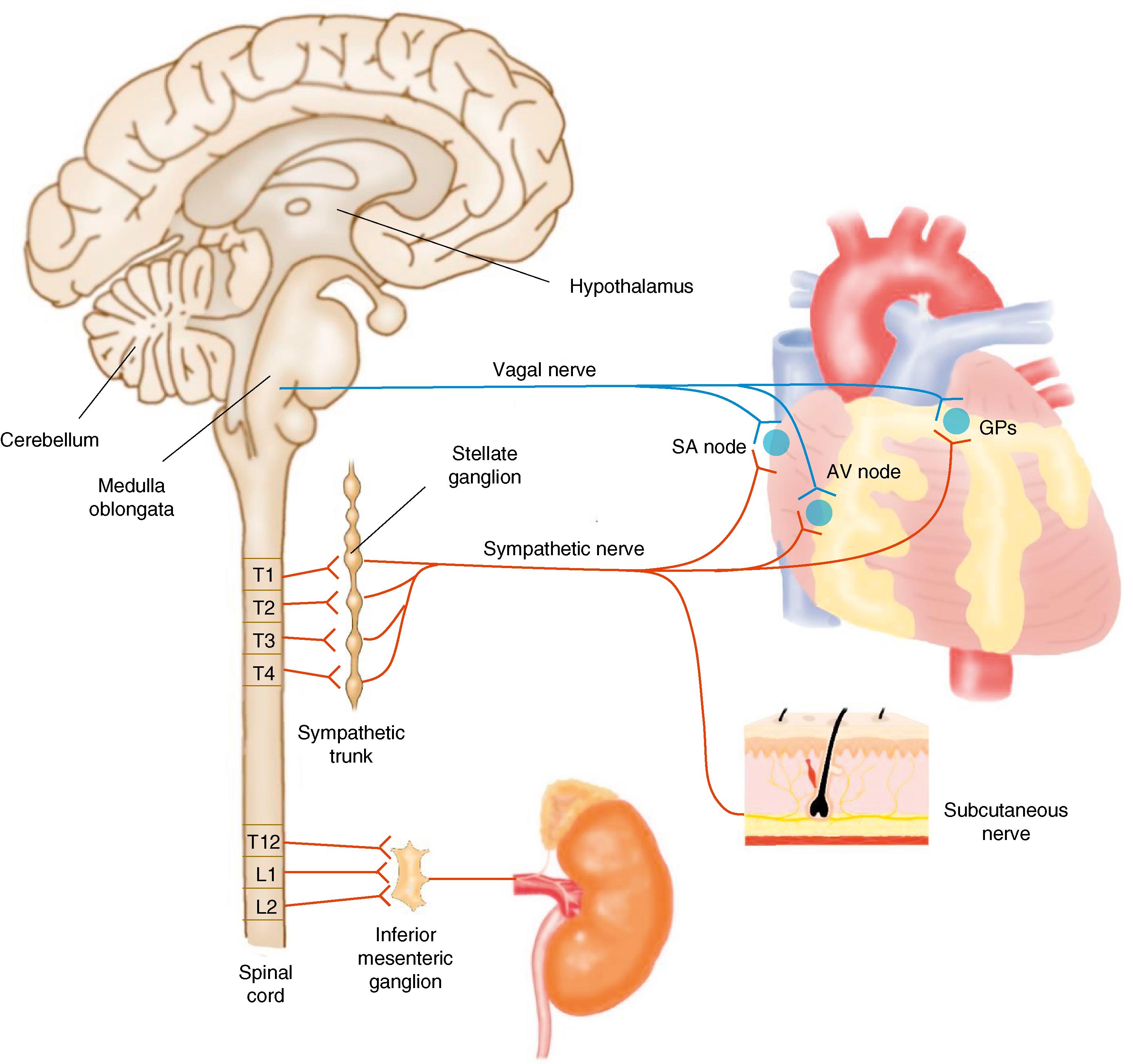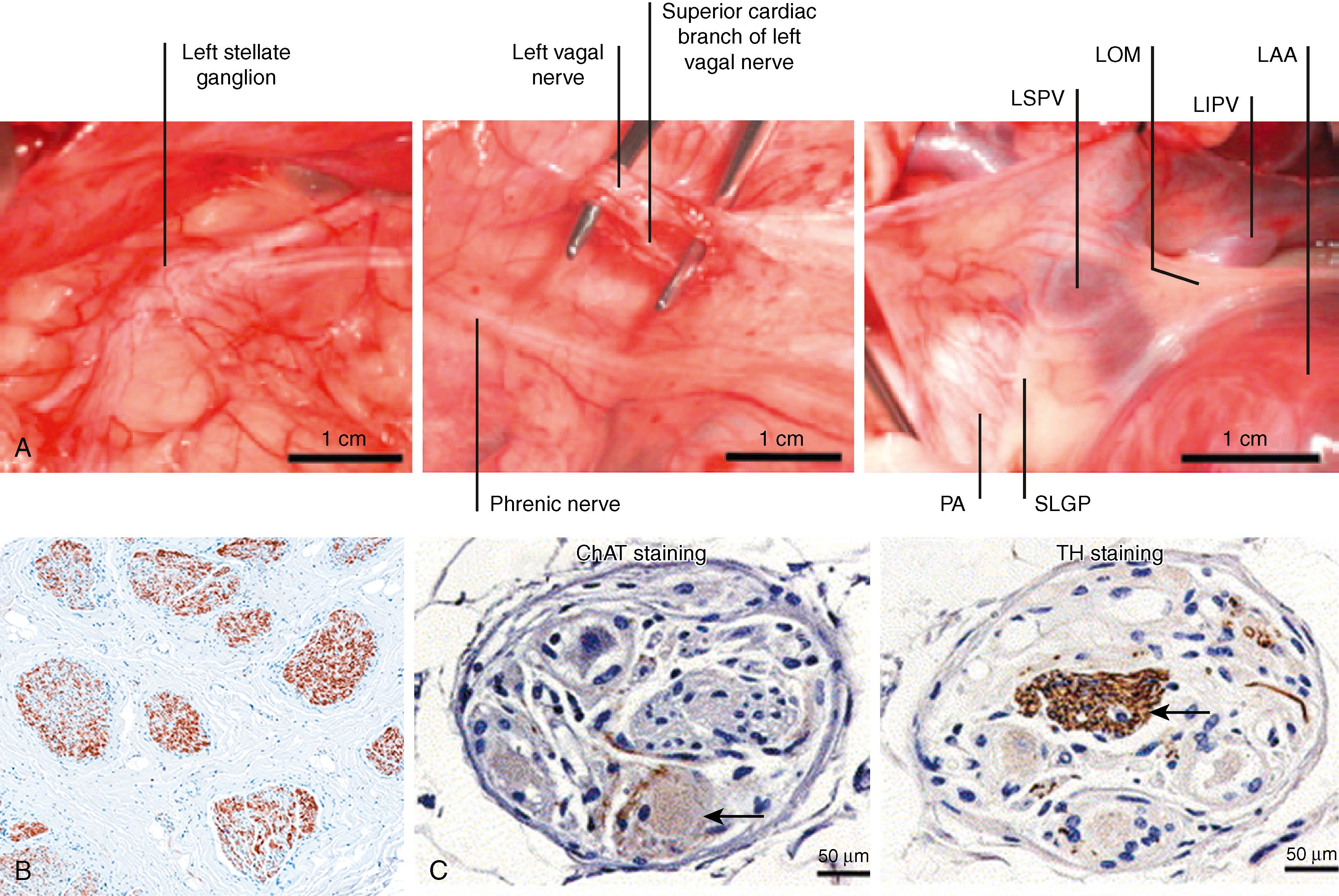Physical Address
304 North Cardinal St.
Dorchester Center, MA 02124
This study was supported in part by National Institutes of Health (NIH) grants R01HL139829 and 1OT2OD028190 (Dr. Chen), a Charles Fisch Cardiovascular Research Award endowed by Dr. Suzanne B. Knoebel of the Krannert Institute of Cardiology (Drs. Kusayama and Everett), a Medtronic-Zipes Endowment, and the Indiana University Health-Indiana University School of Medicine Strategic Research Initiative (Dr. Chen).
The autonomic nervous system (ANS) plays a central role in atrial and ventricular cardiac arrhythmogenesis. , Atrial fibrillation (AF) is the most common cardiac arrhythmia in both developing and developed countries and is associated with an increased risk of all-cause mortality and complications, including stroke and heart failure (HF). Direct nerve recordings in ambulatory canine models and in humans showed that ANS activations are direct triggers of atrial tachycardia (AT) and AF. Neuromodulation techniques that reduce ANS activity have been attempted both in animal models and in humans to suppress atrial arrhythmias. This chapter summarizes recent developments relevant to the neural mechanisms of atrial arrhythmias.
There are extrinsic and intrinsic ANSs in the heart ( Fig. 40.1 ). The extrinsic cardiac ANS has both sympathetic and parasympathetic components. The sympathetic cardiac fibers are largely derived from major paravertebral ganglia, including the superior cervical ganglia, which communicate with C1–3 spinal cord, the stellate ganglion (SG), or cervicothoracic ganglion ( Fig. 40.2A , left), which communicates with C7–8 to T1–2 (see Fig. 40.1 ), and the thoracic ganglia (as low as the 7th thoracic ganglion). Among them, the SG is a major source of cardiac sympathetic innervation, connecting with multiple intrathoracic nerves and structures and the skin (see Fig. 40.1 ). The ganglion cells and nerve fibers of the SG mostly stain positive for tyrosine hydroxylase (TH), indicating a sympathetic phenotype. However, a small percentage of ganglion cells are negative for TH and positive for choline acetyltransferase (ChAT) indicating that these cells may produce acetylcholine. Some of the cells stain positive for both TH and ChAT. Generally, TH-negative cells account for about 5% of the ganglion cells in the SG. Neuromodulation methods, such as vagal nerve stimulation (VNS) and subcutaneous nerve stimulation (ScNS), may significantly increase the percentage of ganglion cells that are TH negative.


The extrinsic parasympathetic fibers that come from nuclei in the medulla are carried almost entirely within the vagal nerve and are divided into superior, middle, and inferior branches (see Fig. 40.2A , middle). Most of the cardiac parasympathetic nerve fibers converge at a distinct fat pad between the superior vena cava and the aorta (known as the “third fat pad”) en route to the sinus and atrioventricular (AV) nodes. Although the vagal nerve carries the parasympathetic nerve fibers, it may also contain significant sympathetic nerve structures. The TH-positive nerves are distributed mostly in the periphery of the vagal nerve in canine models but may be seen throughout the cross section in humans (see Fig. 40.2B ). Vagal nerve recordings in ambulatory dogs showed that vagal activation is often associated with a reduced heart rate, suggesting parasympathetic activation. , However, occasionally vagal nerve activation alone without SG activation is associated with tachycardia, consistent with activation of the sympathetic component of the vagal nerves. Therefore the terms “vagal” and “parasympathetic” should not be used interchangeably. Commonly used terms such as “vagal tone” and “vasovagal response” may be anatomically incorrect.
The heart is innervated by an exquisitely complex intrinsic cardiac ANS. Armour and coworkers provided a detailed map of the distribution of autonomic nerves in human hearts. Throughout the heart, numerous cardiac ganglia, each of which contains 200 to 1000 neurons, , form synapses with the sympathetic and parasympathetic fibers that enter the pericardial space. The vast majority of such ganglia are organized into ganglionated plexi (GPs) on the surface of the atria and ventricles (see Fig. 40.2A , right). GPs contain large populations of colocalized sympathetic and parasympathetic neurons. The intrinsic cardiac ANS thus forms a complex network composed of GPs (concentrated within epicardial fat pads) and the interconnecting ganglia and axons. , , These GPs may function as the “integration centers” that modulate the intricate autonomic interactions between the extrinsic cardiac ANS and the intrinsic cardiac ANS. In the atria, GPs are concentrated in distinct locations on the chamber walls. , , Specifically, the sinus node is primarily innervated by the right atrial GP, whereas the AV node is innervated by the inferior vena cava–inferior atrial GP (IVC-IAGP), which is located at the junction of the inferior vena cava and the left atrium. , , , Another region with a high density of GPs is the pulmonary vein–left atrium (PV-LA) junction, and these GPs are characterized by colocalization of adrenergic and cholinergic nerves (see Fig. 40.2C ). The importance of these GPs is discussed later in this chapter.
Sympathetic activation of the heart serves to enhance cardiac output during fight-or-flight reactions by increasing Ca 2+ entry into myocytes via the L-type Ca 2+ channel, followed by Ca 2+ -induced Ca 2+ release from, and subsequent uptake by, the sarcoplasmic reticulum. , On the other hand, parasympathetic activation of the heart can activate I KACh , reducing the atrial action potential duration (APD) and in turn the atrial effective refractory period (ERP). Another important repolarization current in the atria is the apamin-sensitive small conductance calcium activated potassium (SK) current (I KAS ). Recent data show that I KAS can be activated by isoproterenol in female but not male rabbit ventricles. Whether or not sympathetic stimulation causes sex-specific atrial I KAS activation in humans remains unknown.
Experimental models have shown that acetylcholine infusion into the sinus node artery invariably induces AF in dogs; acetylcholine-mediated AF was facilitated by the β-adrenoceptor agonist isoproterenol, which decreased the threshold concentration of acetylcholine required for the induction and maintenance of prolonged episodes of AF. Sympathetic activation promotes focal ectopic activity via each of the principal cellular mechanisms: enhanced automaticity, early afterdepolarization (EAD), or delayed afterdepolarization. Parasympathetic activity produces spatial electrophysiological heterogeneity of the atria. Mechanistically, if both simultaneous sympathetic and parasympathetic activations occur, atrial APD would be shortened, whereas the Ca 2+ transient would be large and long. Short APD and large Ca 2+ transient create a condition for late phase 3 EADs that can induce triggered activity and AF. , Short APD also promotes the maintenance of reentrant activity. As pulmonary veins naturally have short APDs, they might be prone to develop these Ca 2+ transient-triggered arrhythmias. Electrical stimulation to the GPs around the pulmonary veins can stimulate both adrenergic and cholinergic nerves and possibly trigger atrial tachyarrhythmias by this mechanism. Consistent with the latter hypothesis, spontaneous GP activations in dogs and in humans are associated with atrial arrhythmogenesis. ,
Become a Clinical Tree membership for Full access and enjoy Unlimited articles
If you are a member. Log in here